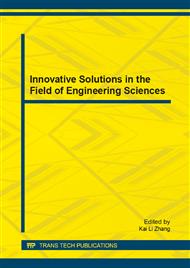[1]
Ahmad Kamal Aijazi, Paul Checchin, and Laurent Trassoudaine. Segmentation Based Classification of 3D Urban Point Clouds: A Super-Voxel Based Approach with Evaluation. Remote Sens. 2013, 5, 1624-1650.
DOI: 10.3390/rs5041624
Google Scholar
[2]
D. Maier and Alexander Kleiner, Improved GPS Sensor Model for Mobile Robots in Urban Terrain, IEEE Int. Conf. on Robotics and Automation (ICRA), 2010, 4385-4390.
DOI: 10.1109/robot.2010.5509895
Google Scholar
[3]
Howard, A Real-time stereo visual odometry for autonomous ground vehicles. International conference on Intelligent Robots and Systems. Piscatawa, 2008, pages 3946-3952.
DOI: 10.1109/iros.2008.4651147
Google Scholar
[4]
Liu Ruizhen, Yu Shiqi. OpenCV tutorials. Beijing: Beihang University Press. 2009. Liu Zhenyu, Jiang Nan, Zhang Lingtao. Self-localization of mobile robots based on artificial landmarks and stereo vision. Computer Engineering And Applications. 41(2010).
Google Scholar
[5]
Radu Bogdan Rusu, Nico Blodow, Zoltan Csaba Marton, and Michael Beetz. Close-range Scene Segmentation and Reconstruction of 3D Point Cloud Maps for Mobile Manipulation in Human Environments. In Proceedings of the IEEE/RSJ International Conference on Intelligent Robots and Systems (IROS), St. Louis, MO, USA, October 11-15 (2009).
DOI: 10.1109/iros.2009.5354683
Google Scholar
[6]
Stentz Anthony, Kelly Alonzo, Rander Peter, Herman Herman, Amidi Omead, Mandelbaum Robert, Salgian Garbis, and Pedersen Jorgen. Real-Time, Multi-Perspective Perception for Unmanned Ground Vehicles. Robotics Institute. Paper 16. (2003).
Google Scholar
[7]
Strom, J., Richardson, A., Olson, E., Graph-Based Segmentation for Colored 3D Laser Point Clouds. In Proceedings of the IEEE/RSJ International Conference on Intelligent Robots and Systems (IROS), Taipei, Taiwan, 18–22 October 2010; p.2131–2136.
DOI: 10.1109/iros.2010.5650459
Google Scholar
[8]
Thompson S, Kagami S. Stereo Vision Terrain Model for Non-Planar Mobile Robot Mapping and Navigation, IEEE International Conference on System, Man and Cybernetics, volume 6, pages 5392-5397, 10-13 October, (2004).
DOI: 10.1109/icsmc.2004.1401051
Google Scholar
[9]
Zhu Dehai, Guo Hao, Su Wei. Point Cloud Library tutorials. Beijing: Beijing Institute of Technology Press. (2012).
Google Scholar
[10]
Klasing, K., Althoff, D., Wollherr, D. Buss, M. Comparison of Surface Normal Estimation Methods for Range Sensing Applications. In Proceedings of the IEEE International Conference on Robotics and Automation, Kobe, Japan, 12–17 May 2009; p.3206.
DOI: 10.1109/robot.2009.5152493
Google Scholar
[11]
Lingua, A, Marenchino, D, Nex, F, Performance analysis of the SIFT operator for automatic feature extraction and matching in photogrammetric applications. Sensors , 2009, 9, 3745-3766.
DOI: 10.3390/s90503745
Google Scholar


